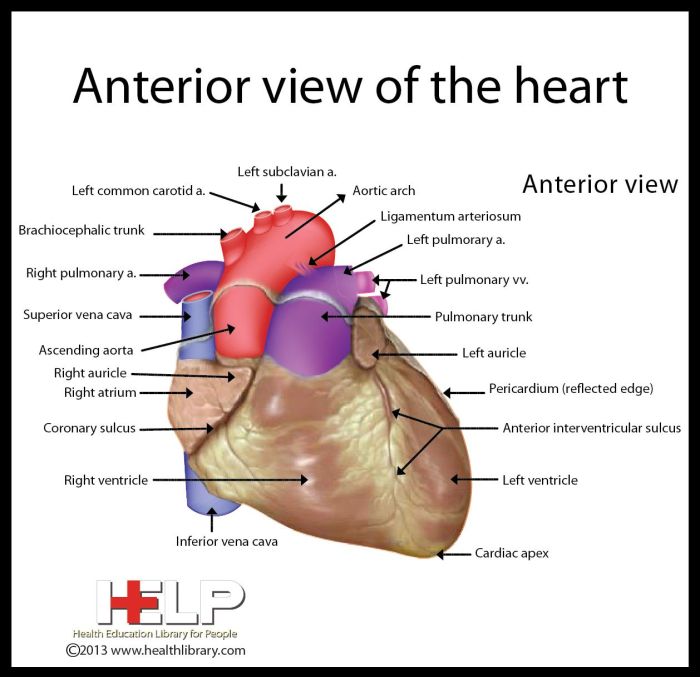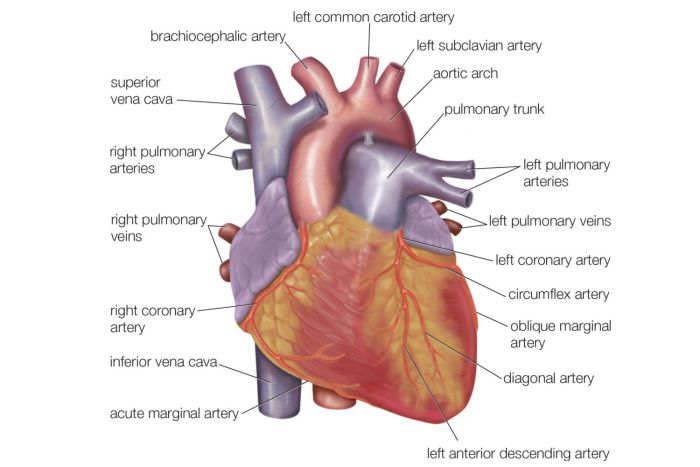Correctly label the external anatomy of the anterior heart – Correctly labeling the external anatomy of the anterior heart is a fundamental skill for medical professionals, providing a crucial foundation for understanding cardiac structure and function. This guide offers a comprehensive overview of the major structures, vessels, valves, and surface anatomy of the anterior heart, empowering readers with the knowledge necessary for accurate diagnosis and effective patient care.
Delving into the intricacies of the anterior heart, we will explore the right and left ventricles, atria, aorta, pulmonary artery, and major veins, unraveling their intricate interplay in maintaining the vital flow of blood. Additionally, we will delve into the clinical significance of correctly labeling these structures, highlighting their importance in diagnostic procedures, surgical interventions, and patient education.
Introduction

Correctly labeling the external anatomy of the anterior heart is crucial for accurate diagnosis, surgical interventions, and patient education. The anterior surface of the heart is visible through the thoracic cavity and comprises various anatomical structures that play vital roles in cardiac function.
Major Structures

The major structures visible on the anterior heart surface include:
- Right ventricle
- Left ventricle
- Right atrium
- Left atrium
Vessels and Valves
The anterior heart is associated with major vessels and valves, such as:
- Aorta
- Pulmonary artery
- Superior vena cava
- Inferior vena cava
- Mitral valve
- Tricuspid valve
Surface Anatomy
The anterior heart is located within the thoracic cavity, extending from the sternum to the left midclavicular line. It is situated behind the ribs and sternum, with the apex of the heart pointing toward the left. Surface anatomy includes:
- Palpation: The apex of the heart can be palpated in the fifth intercostal space, left midclavicular line.
- Auscultation: Heart sounds, such as S1 and S2, can be auscultated over the anterior surface.
Clinical Significance
Correctly labeling the external anatomy of the anterior heart is crucial for:
- Diagnostic procedures:Accurate labeling enables precise localization of heart structures during echocardiography, electrocardiography, and other diagnostic tests.
- Surgical interventions:Proper labeling guides surgeons during cardiac surgeries, such as valve replacements and bypass procedures.
- Patient education:Understanding the anatomy of the anterior heart helps patients visualize and comprehend cardiac conditions and treatment options.
Variations and Anomalies

Common variations and anomalies in the external anatomy of the anterior heart include:
- Transposition of great vessels:Aorta and pulmonary artery are switched in position.
- Tetralogy of Fallot:A combination of four heart defects, including ventricular septal defect and pulmonary stenosis.
- Double-outlet right ventricle:Both great vessels arise from the right ventricle.
Understanding these variations is essential for accurate diagnosis and appropriate clinical management.
Question & Answer Hub: Correctly Label The External Anatomy Of The Anterior Heart
Why is it important to correctly label the external anatomy of the anterior heart?
Accurate labeling provides a common language for medical professionals, facilitating effective communication and collaboration in patient care.
What are the major structures visible on the anterior surface of the heart?
The right and left ventricles, right and left atria, aorta, and pulmonary artery are the primary structures visible on the anterior heart.
How can variations in the external anatomy of the anterior heart impact clinical practice?
Variations may affect the placement of surgical incisions, interpretation of diagnostic tests, and the planning of therapeutic interventions.